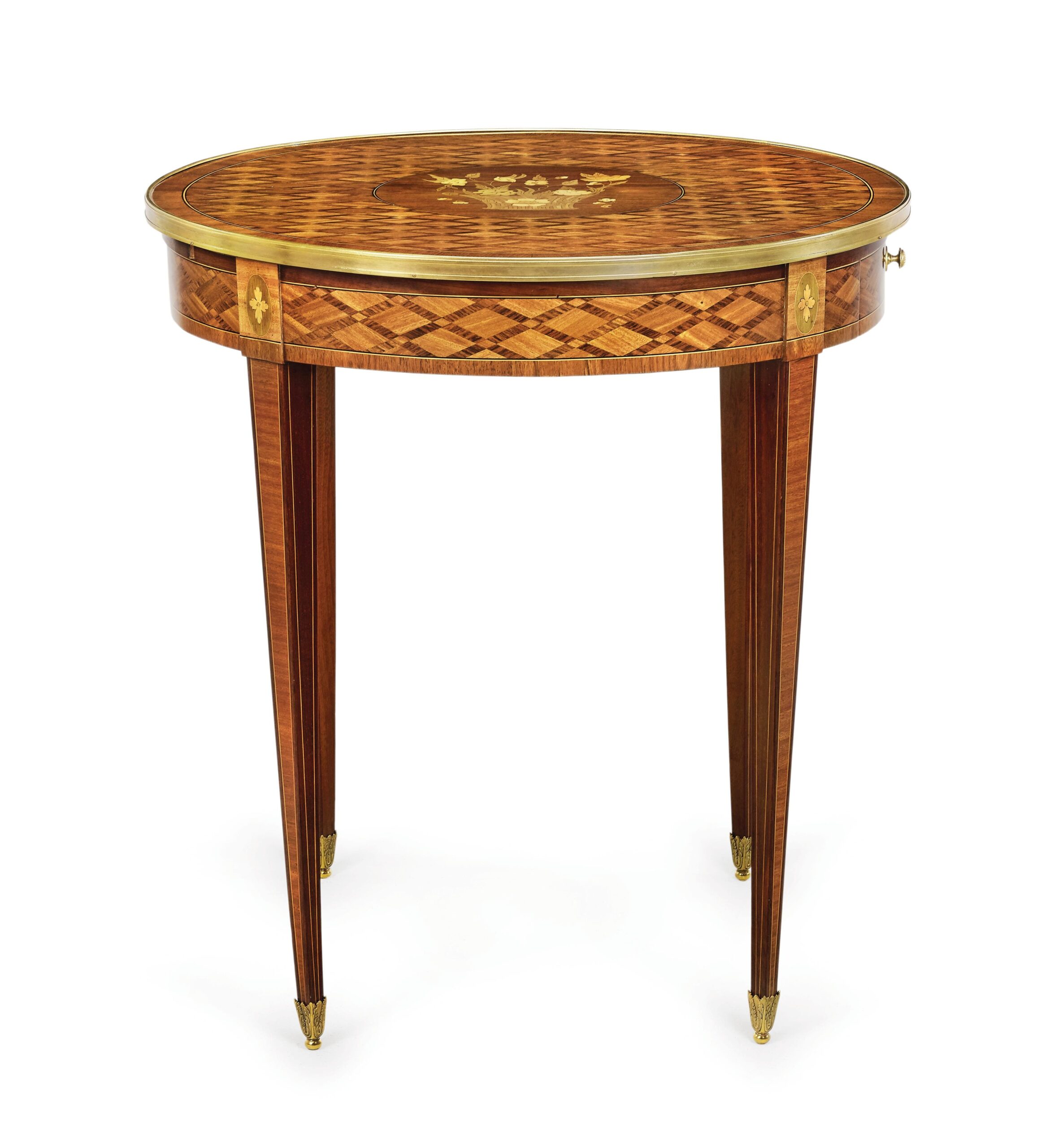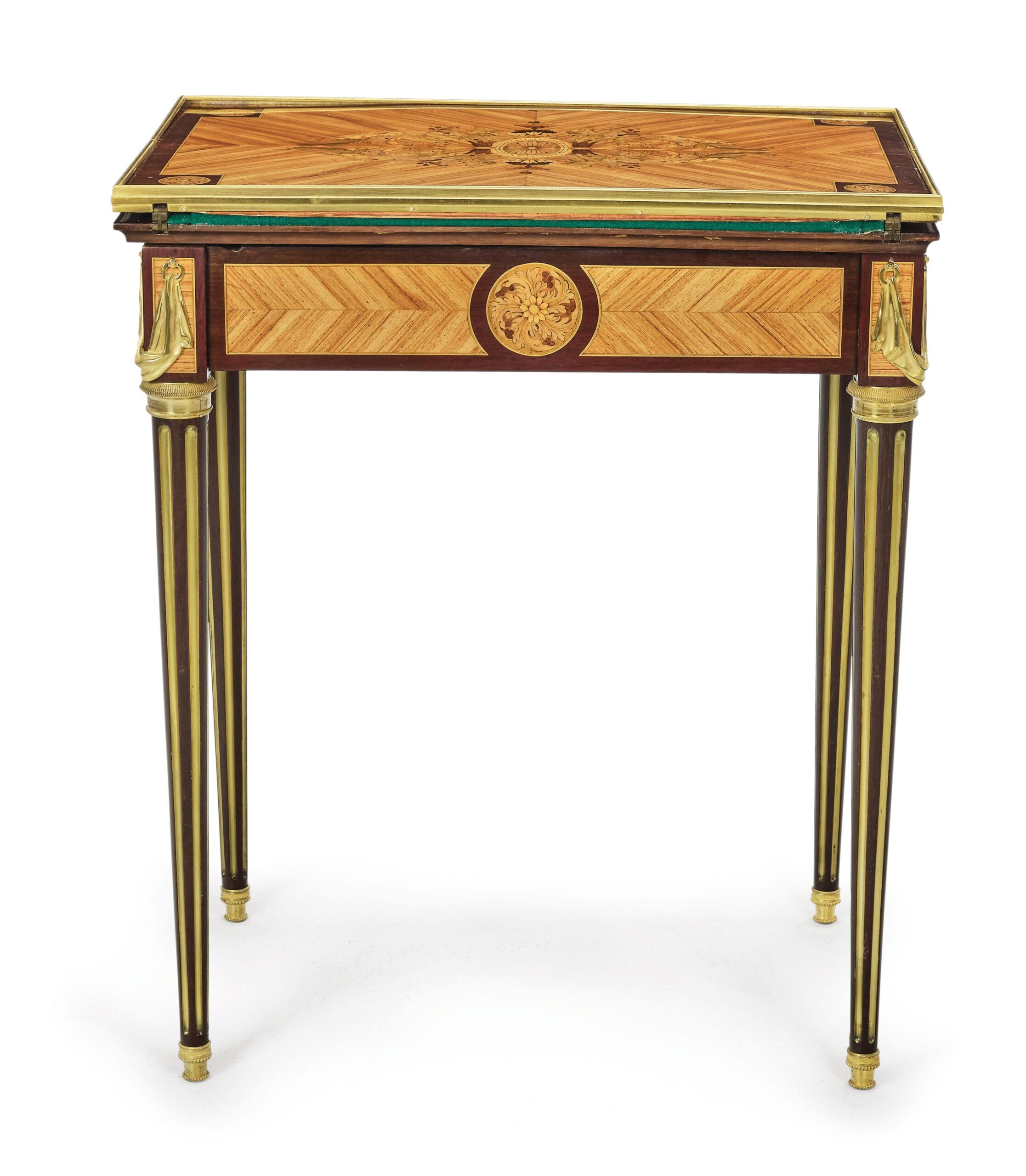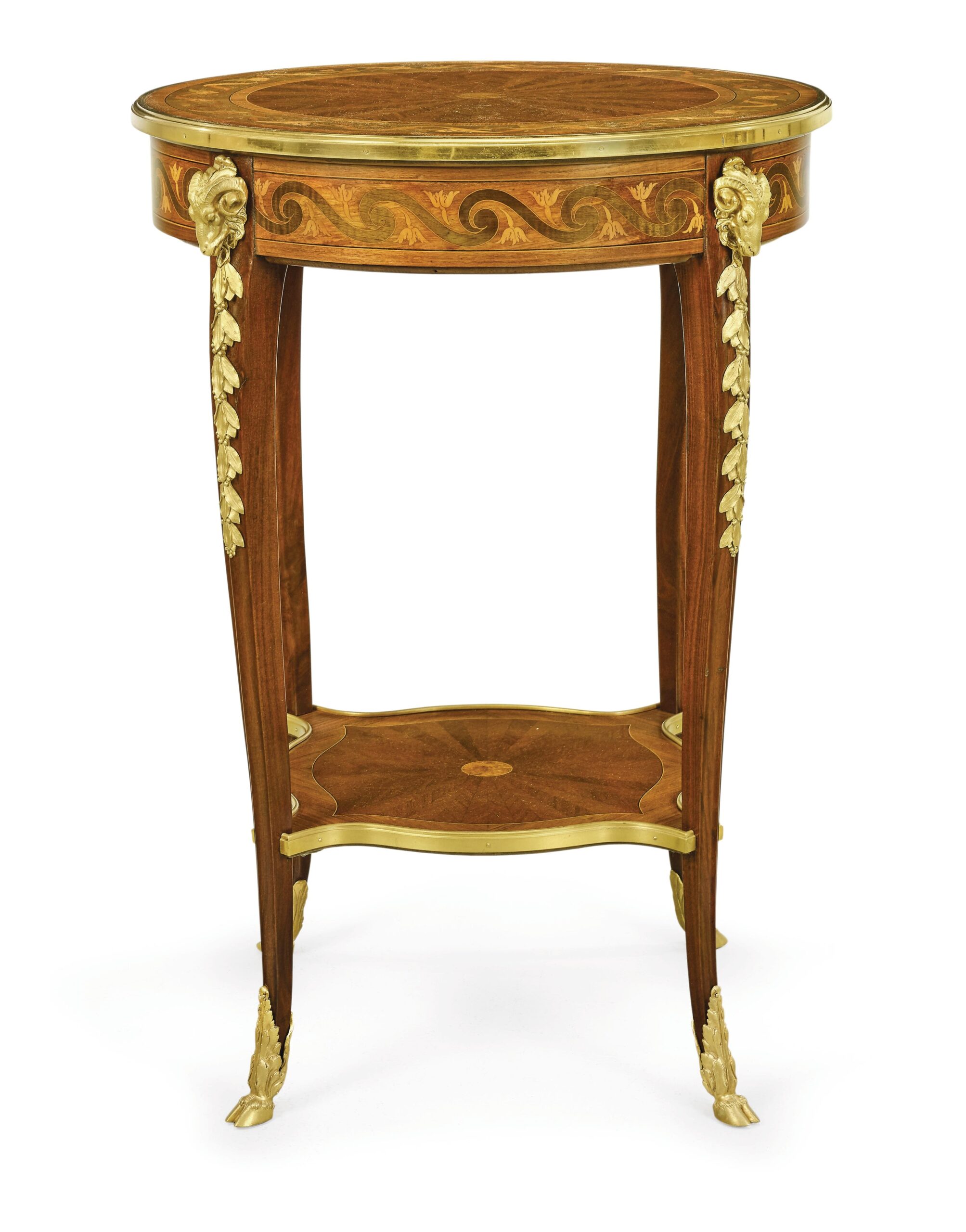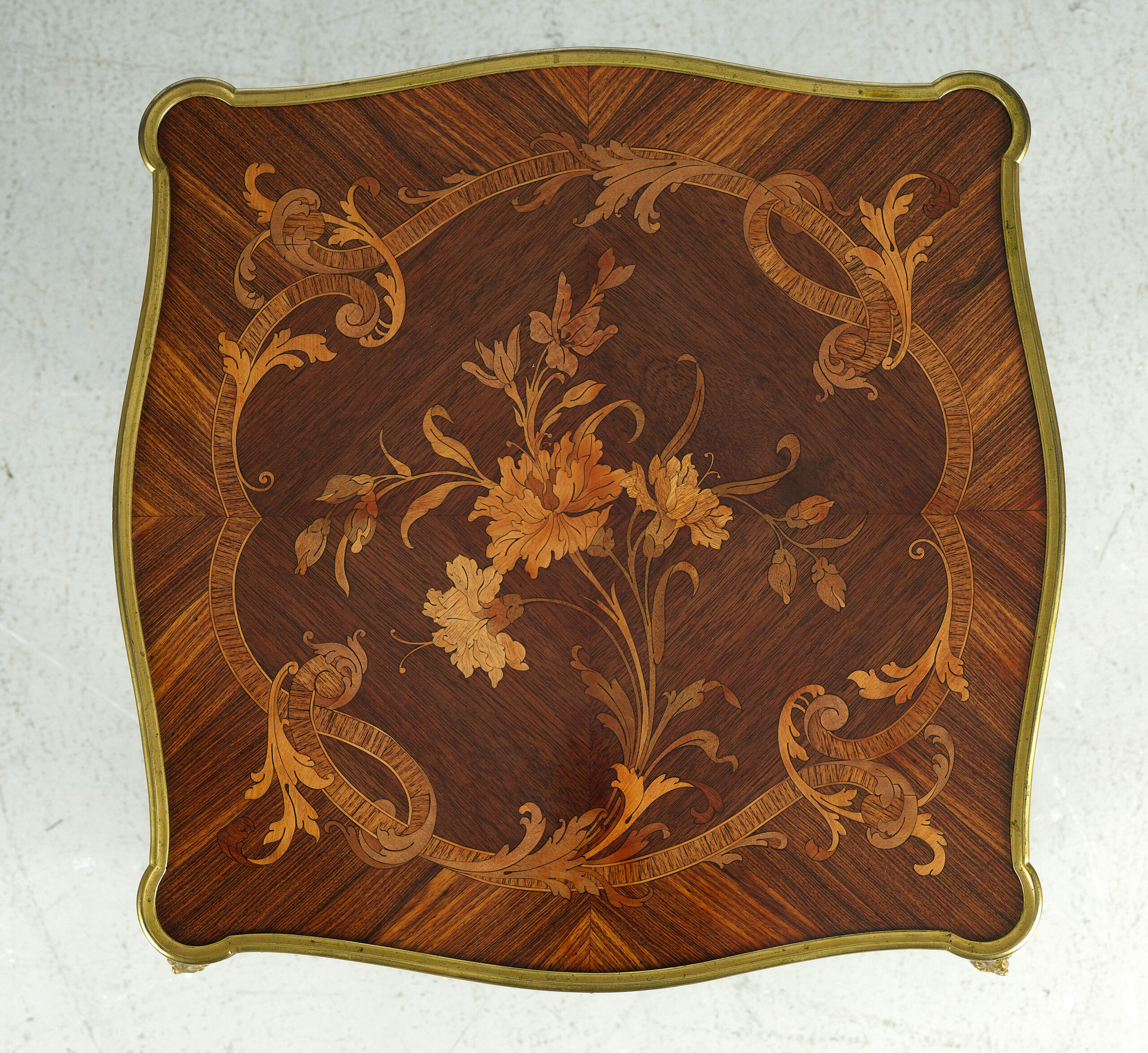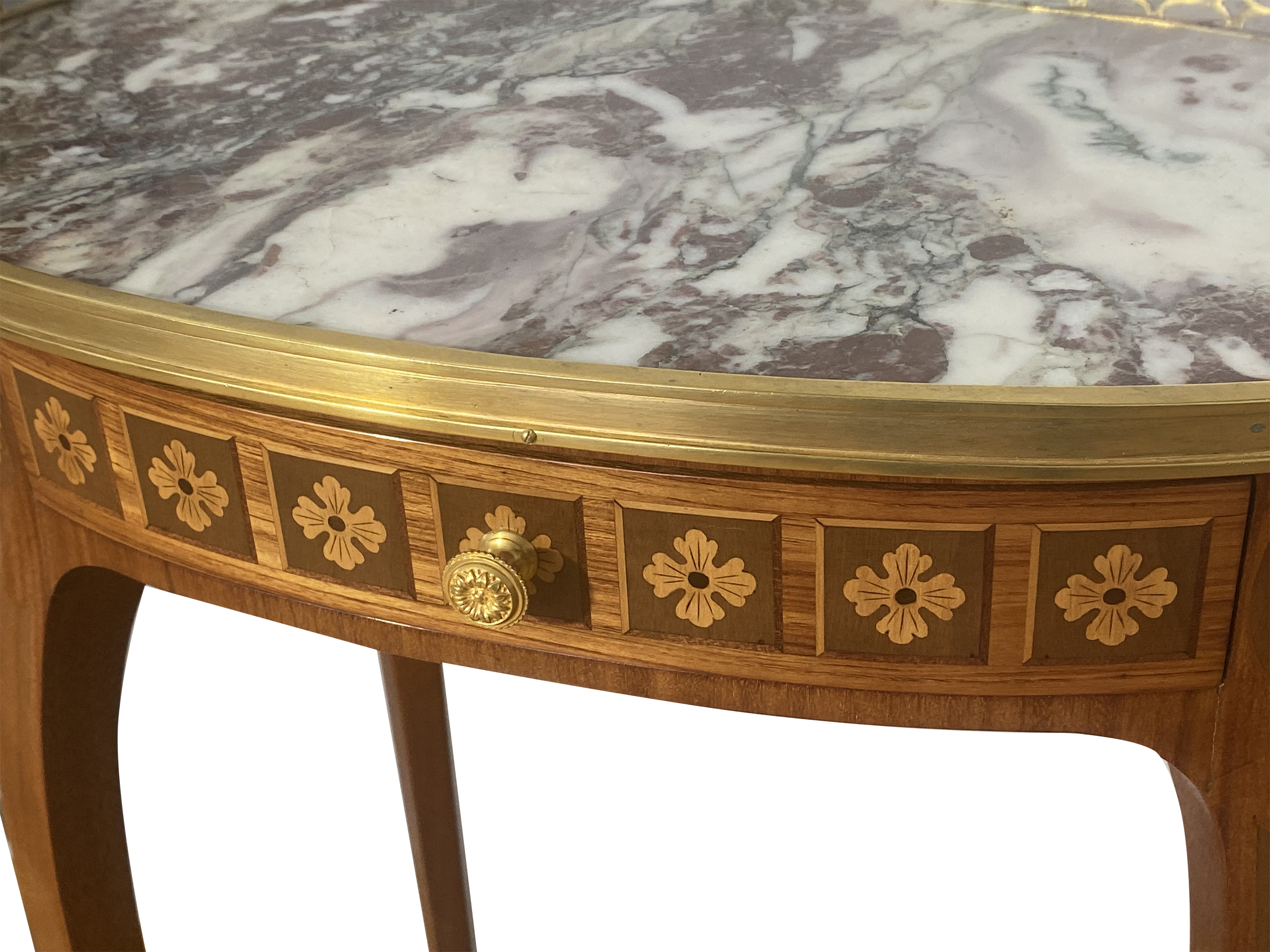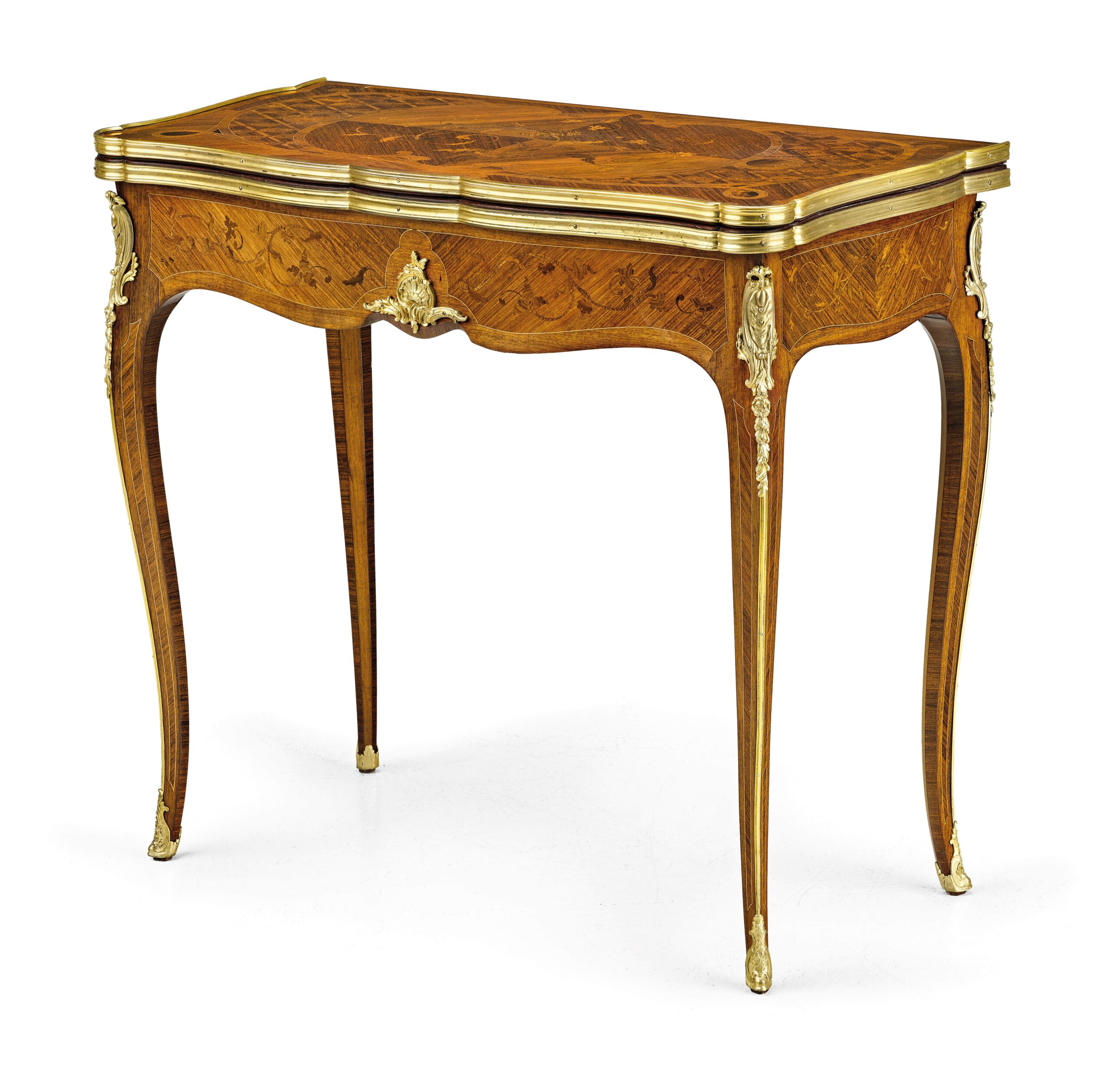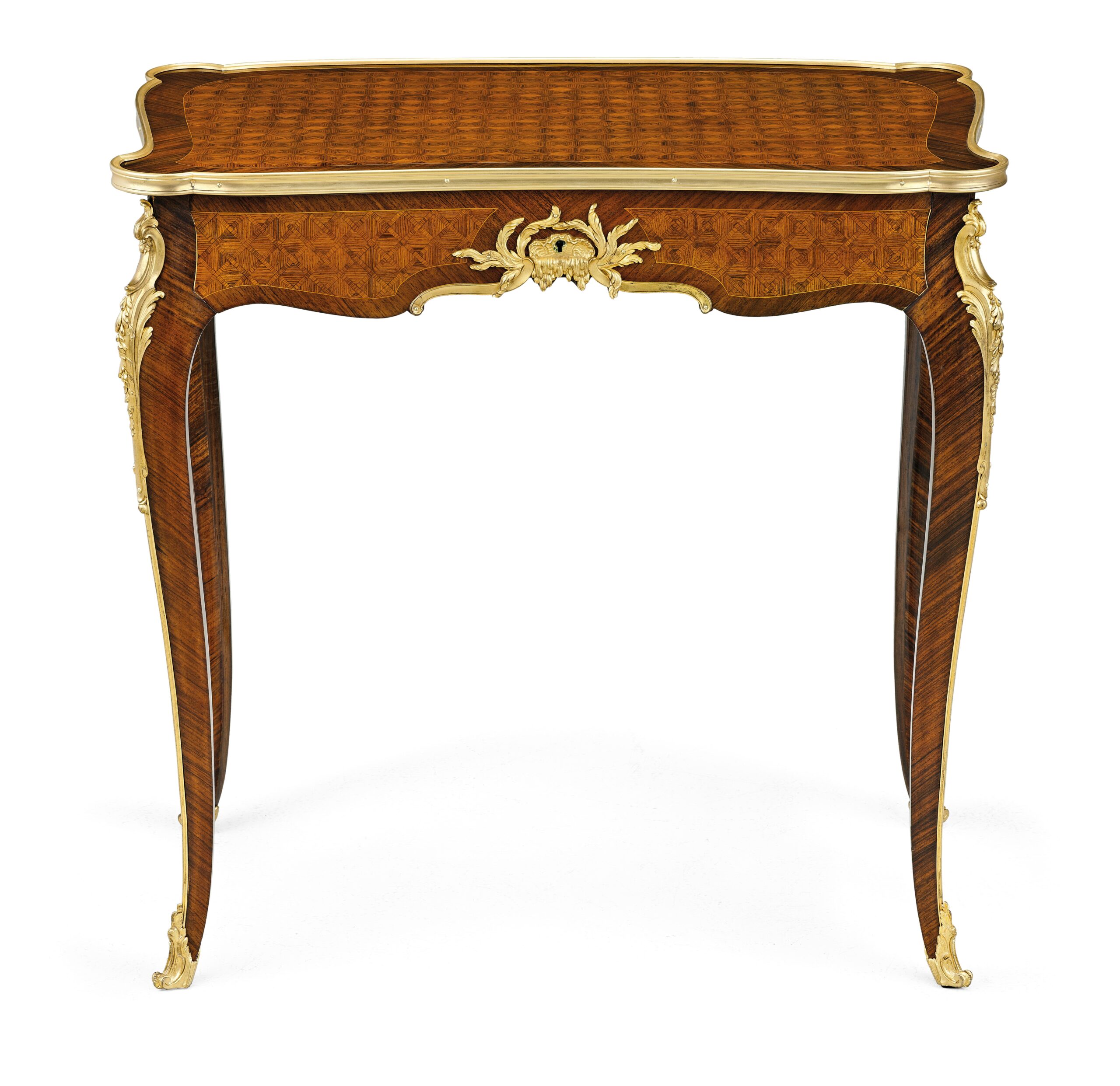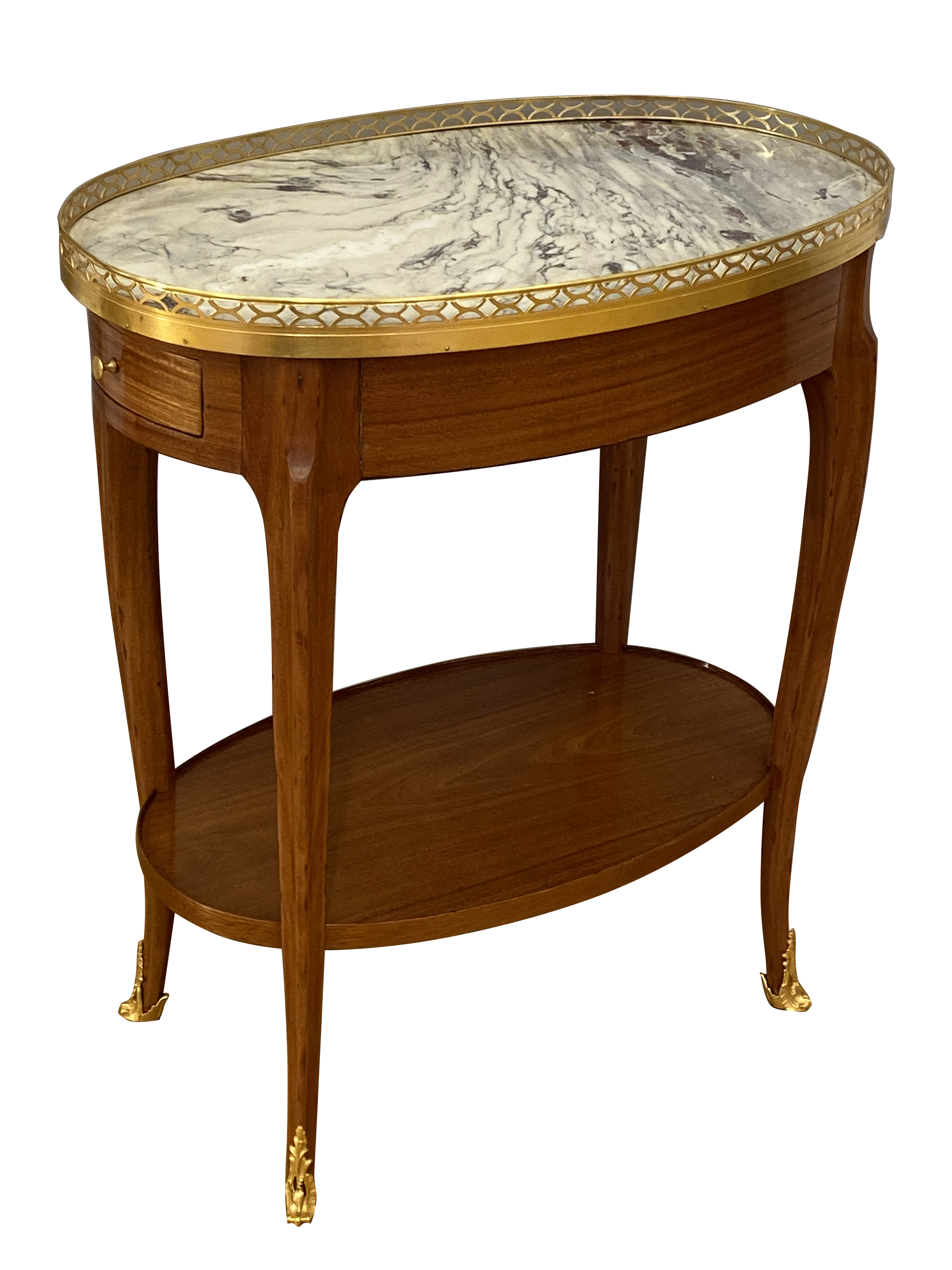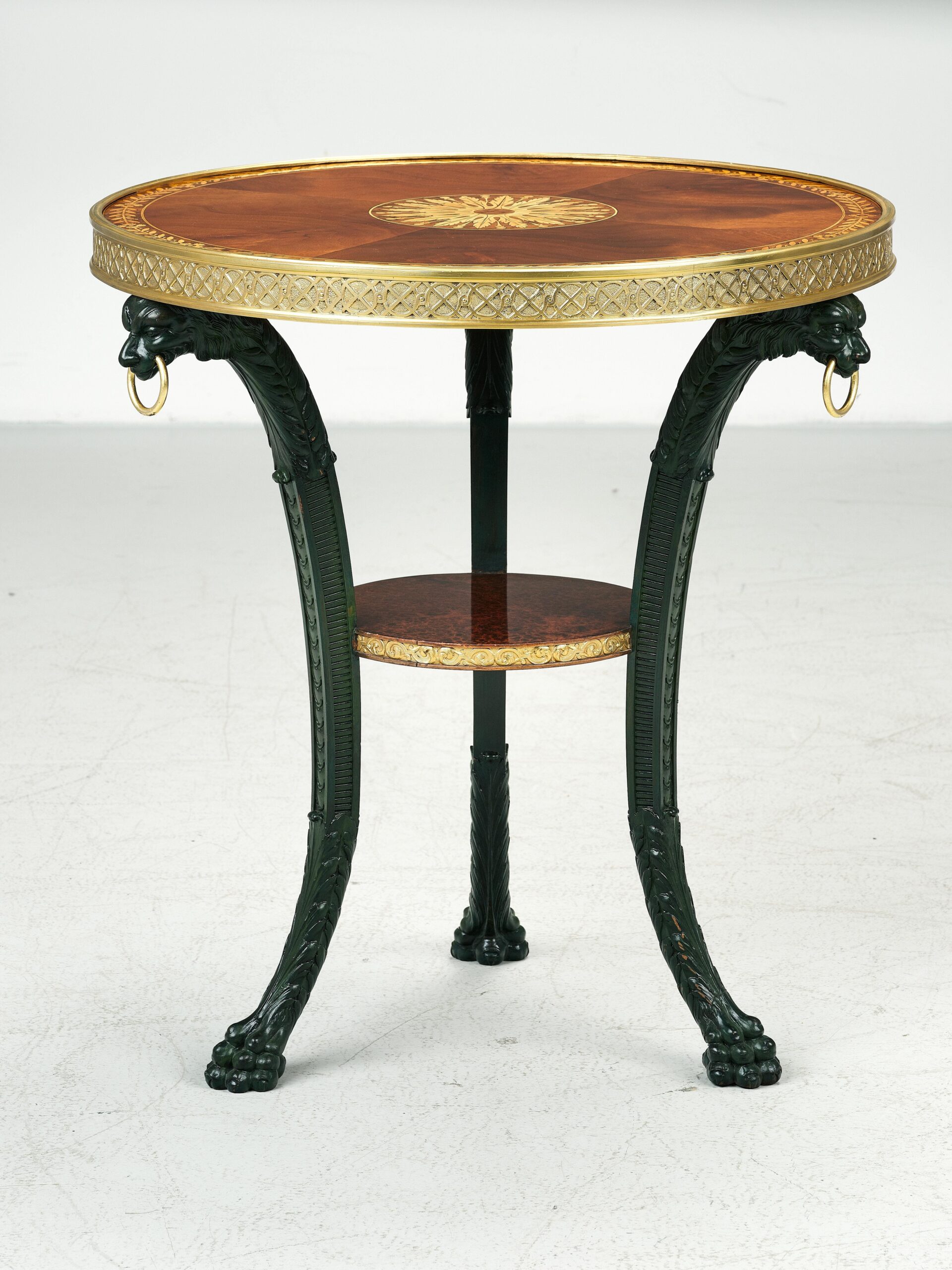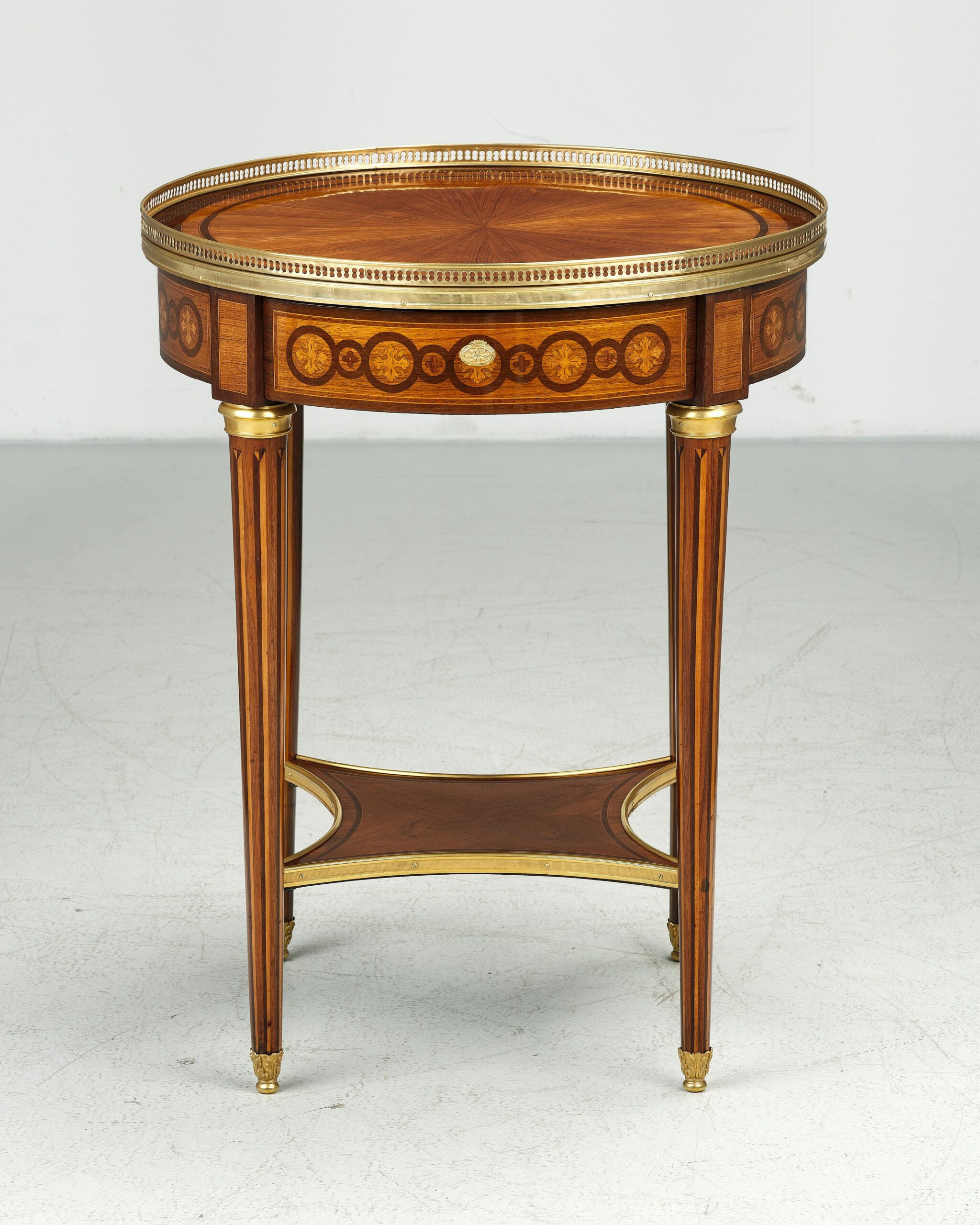Small tables
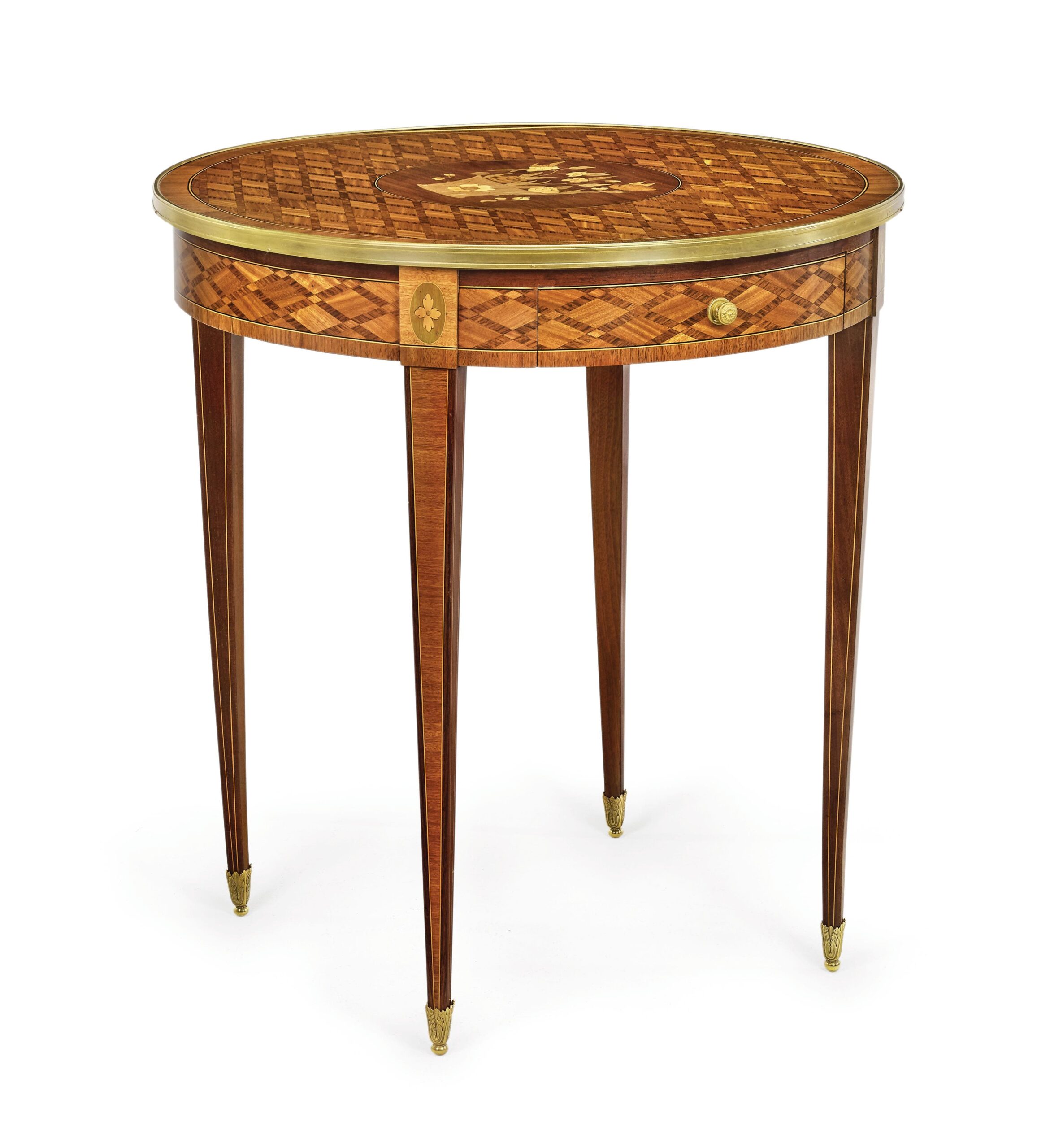
 €4,500.00
€4,500.00so-called “Bouillotte”, in Louis XV style, “Escalier de Cristal” in Paris, late 19th century, various hardwoods and softwoods,
palisade veneered, with various partially coloured precious woods in the form of flowers in a vase and lattice marquetry, polished using traditional craftsmanship, one drawer, one pull-out leather-covered shelf, gilded shelf, gilded bronze fittings and plate surround, conical feet, height 76 cm, diameter 70 cm, beautiful professionally restored condition.
 €4,800.00
€4,800.00A console by the French ebenist Georges-Francois ALIX, in the Louis XVI style, late 19th century, oak frame veneered with amaranth and rosewood as well as with various precious woods of the finest quality in the form of stylised leaves and flowers as well as ornamental marquetry, polished using traditional craftsmanship, conical fluted feet, hinged top, gilded bronze fittings, double stamp on the underside, 74 x 63 x 44 cm, professionally restored condition.

 Sold
SoldBy the HAENTGES FRERES company in Paris, late 19th century, predominantly oak, mahogany veneered,
ornamentally decorated with various precious woods and in the form of musical instruments and sheet music, curved feet, one intermediate compartment and one drawer, a small table with company label, gilded bronze gilt bronze edging, 72 x 47 x 31 cm, beautiful professionally restored condition.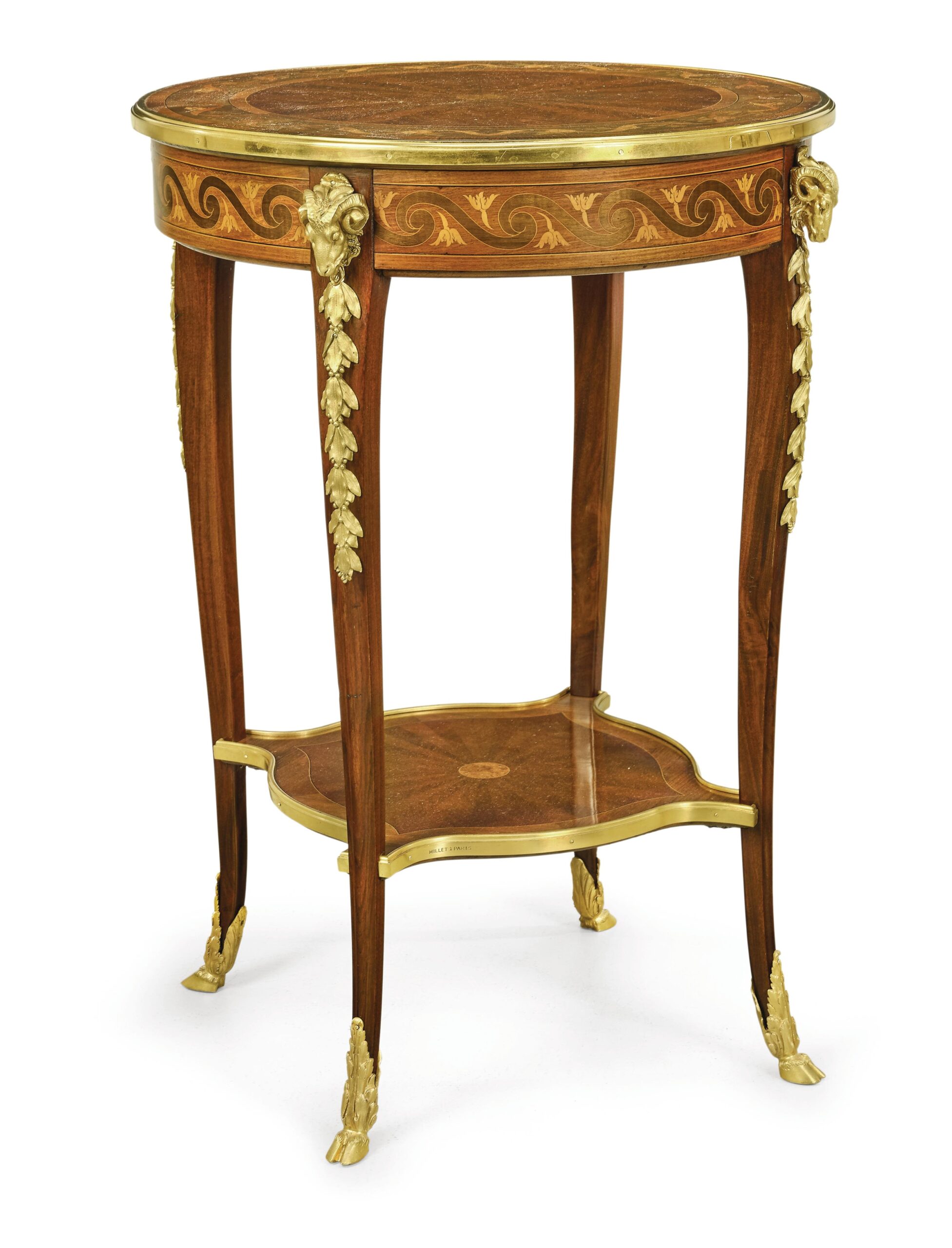
 Sold
SoldFrance, late 19th century. Elegantly curved oak frame, rosewood veneered, finely ornamentally marquetry with various, partly coloured precious woods, polished in traditional technique, one intermediate compartment, finely chased, partly in the form of rams’ heads and laurel leaves, gilded bronze fittings, intermediate compartment and top with border, signed, MILLET a PARIS, height 75.5 cm, diameter 52.5 cm, beautiful professionally restored condition.

 €5,000.00
€5,000.00Paris, after an 18th century model by Bernard II van Risenburgh, crafted in the 2nd half of the 19th century, curved oak frame, rosewood veneered, marquetry with various precious woods in the so-called end grain technique, polished in the traditional craftsman’s technique, one drawer, finely chiselled gilded mounts, moulded plate surround, lock stamped “P. Sormani á Paris”. The frame is made of curved oak, rosewood veneered, inlaid with various precious woods in the so-called end grain technique, polished using traditional craftsmanship, one drawer, finely chiselled gilded fittings, profiled panel edging, embossed lock “P. Sormani á Paris”, 72.5 x 64 x 39 cm, in beautiful, expertly restored condition. Subject to species protection (ASB)
Paul SORMANI (1817-1877) founded his company in 1847 and also took over his brother’s business in 1858. Above all, the extremely precise construction, always made of oak wood, was rightly regarded as unrivalled. In 1855, 1862 and 1867, Sormani took part in the world exhibitions in Paris and London and won numerous awards and medals. The company was commercially very successful and employed up to 300 craftsmen at 10, rue Charlot, shortly before the founder’s death in 1877. From 1877, the company was run by the widow Ursule Marie Philippine and his son Paul-Charles under the name “Sormani Veuve et Fils” until 1914. In 1889, the company won the Grand Prix at the Universal Exhibition in Paris.

 Sold
SoldIn the transitional style, Paul Sormani, (1817-1877), last quarter of the 19th century, curved oak frame in rosewood finish, ornamentally marked with various precious woods, polished in the traditional manner, rich finely chiselled gilt bronze mountings, the frame with meander decoration, Sormani Paris lock stamping, marble top with border, one drawer, 72 x 71.5 x 47.5 cm, beautiful professionally restored condition.

 Sold
SoldPair of oval side tables, transitional style. Attributed to HAENTGES. France early XX c. Filigree hardwood frames mainly veneered with rosewood and various precious woods marked. White-grey marble top and an intermediate compartment marked in the form of musical attributes. Top and compartment set in gilded galleries. Hand polished with natural shellac. Restored condition.

 €3,200.00
€3,200.00Carries a plaque “A.Vallot – rue des St. Pères”. A furniture company that also distributed F. Linke products. Four-sided curved oak frame with rosewood and mahogany diamond-shaped veneer. Outstanding, finely chiselled bronze doré fittings. 1 intermediate compartment. Double profiled “Fleur de Peche” marble top. Restored condition. Hand polished with natural shellac.

 €6,500.00
€6,500.00- Console table, Gervais-Maximilien Eugene DURAND, (1839-1920) based on a model model of the ebenist Bernard van Risenburgh in the late 19th century curved oak frame with folding top, rosewood veneered, veneered in rosewood, with various precious woods, partly in in end-grain technique, floral and lattice-like markings, polished, finely chiselled gilt bronze fittings and panel edging, interior covering, stamped on the underside of the frame
- 75 x 82 x 42cm
- Beautiful expertly restored condition.

 €5,800.00
€5,800.00Francois LINKE (1855-1946), Paris late 19th/early 20th century, curved oak frame veneered with rosewood, lattice- and diamond-shaped marquetry and diamond-shaped marquetry, polished, one drawer, exquisite gilt bronze exquisite quality bronze fittings, on the bronze underside monograms FL as well as signed F Linke on the edge of the plate border, 73,5 x 74 x 47 cm, beautiful expertly restored condition.

 Sold
SoldSo-called “Bouillotte”, in the Louis XVI style, France, end of the 19th century, various hard and soft woods, veneered with rosewood and amaranth and ornamentally marked with various exotic precious woods, one drawer, conical turned feet, one intermediate compartment, gilded bronze fittings and top edging, height 76 cm, diameter 60 cm, beautiful restored condition.

 €2,500.00
€2,500.00Filigree hardwood frame veneered with rosewood. Table top and intermediate compartment with rosewood, boxwood and various other precious woods in a lattice-like pattern. Top framed in a gilded gallery. Fittings such as rosettes and feet also gilded. Hand polished with natural shellac. Restored condition.


